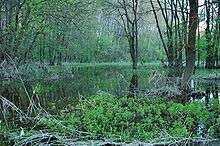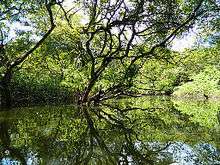Freshwater swamp forest

Freshwater swamp forests, or flooded forests,[1] are forests which are inundated with freshwater, either permanently or seasonally. They normally occur along the lower reaches of rivers and around freshwater lakes. Freshwater swamp forests are found in a range of climate zones, from boreal through temperate and subtropical to tropical.
In the Amazon Basin of Brazil, a seasonally flooded forest is known as a várzea, a use that now is becoming more widespread for this type of forest in the Amazon (though generally spelled varzea when used in English). Igapó, another word used in Brazil for flooded Amazonian forests, is also sometimes used in English. Specifically, varzea refers to whitewater-inundated forest, and igapo to blackwater-inundated forest.
Peat swamp forests are swamp forests where waterlogged soils prevent woody debris from fully decomposing, which over time creates a thick layer of acidic peat.
Freshwater swamp forest ecoregions
Afrotropic
- Eastern Congolian swamp forests (Democratic Republic of the Congo)
- Niger Delta swamp forests (Nigeria)
- Western Congolian swamp forests (Republic of the Congo, Democratic Republic of the Congo).
Australasia
- Northern New Guinea lowland rain and freshwater swamp forests (Indonesia, Papua New Guinea)
- Southern New Guinea freshwater swamp forests (Indonesia, Papua New Guinea)
South Asia
- Borneo peat swamp forests (Brunei, Indonesia, Malaysia)
- Chao Phraya freshwater swamp forests (Thailand)
- Irrawaddy freshwater swamp forests (Myanmar)
- Peninsular Malaysian peat swamp forests (Malaysia, Thailand)
- Ratargul Swamp Forest (Bangladesh)[2]
- Red River freshwater swamp forests]] (Vietnam)
- Southwest Borneo freshwater swamp forests (Indonesia)
- Tonle Sap-Mekong peat swamp forests (Cambodia, Vietnam)
- Wathurana freshwater swamp forest (Sri Lanka)
- Myristica swamp (India)
- Nelapattu Bird Sanctuary (India)
Neotropic
- Cantão igapó forest (Brazil)
- Gurupa varzea (Brazil)
- Iquitos varzea (Bolivia, Brazil, Peru)
- Marajó varzea (Brazil)
- Monte Alegre varzea (Brazil)
- Orinoco Delta swamp forests (Guyana, Venezuela)
- Pantanos de Centla (Mexico)
- Paramaribo swamp forests (Guyana, Suriname)
- Purus varzea (Brazil)
See also
- Coniferous swamp forest


